Cinderblocks
by Frederick Deknatel
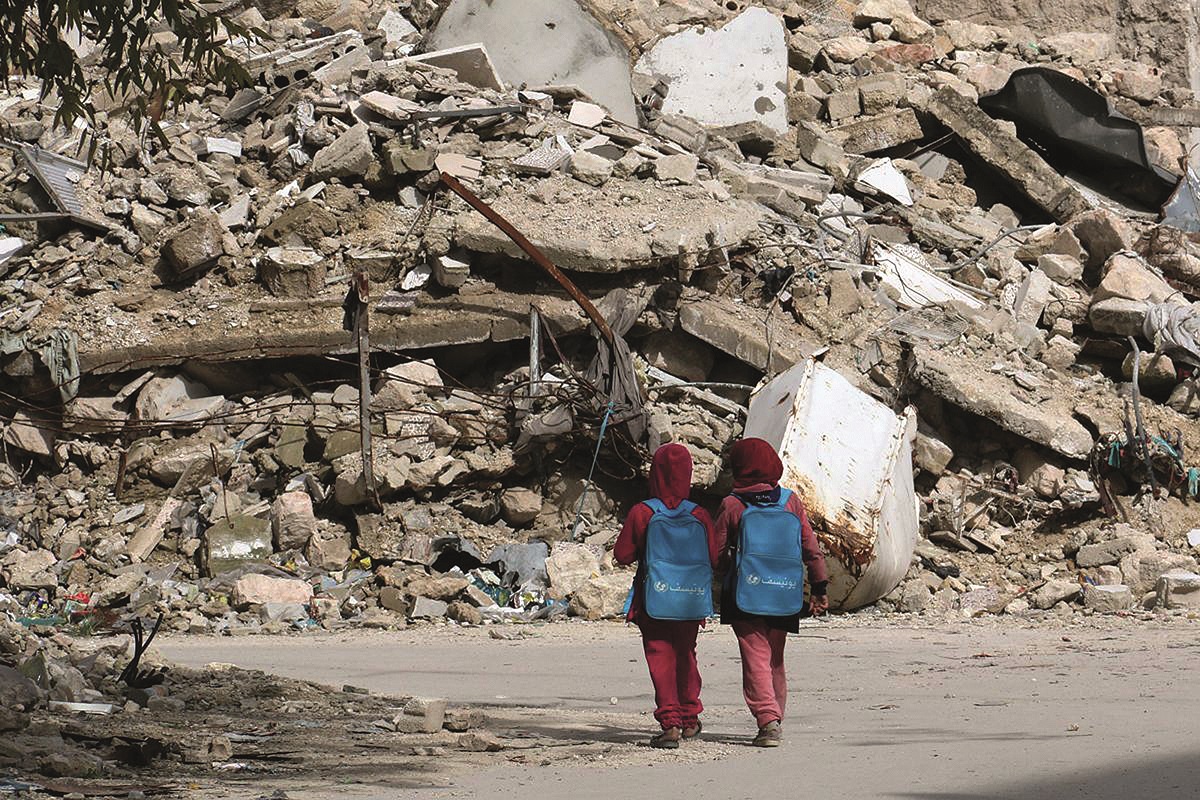
Two girls walk to school through the al-Shaar neighborhood of Aleppo. 2015. Photo: Izein Alrifai
This essay appeared in Even no. 6, published in spring 2017. The Syrian civil war has continued and intensified since the fall of Aleppo; in the first two months of 2018, more than 1,000 children were killed.
I.
In 2010, a consultant for a German development agency known as GTZ, which had been providing technical assistance to the Syrian government for years on widely praised urban restoration projects, published a long report on economic development in Aleppo, Syria’s largest city and commercial hub. Buried in the report’s 170 pages, after the analysis of the manufacturing and chemical industries but before tables of data, was a branding proposal.
“Aleppo is not widely known,” the consultant wrote. “The first part of image development is name recognition.” That the city’s textiles and olive soap weren’t celebrated abroad put Aleppo’s merchants and its budding tourism sector at a disadvantage. But the consultant had a few ideas, starting with promotional advertising of “Aleppo textiles” and “Aleppo soap”—similar, he said, to the branding of Alaskan trout and Maine lobster. The city could adopt its own naming rights, modeled on Champagne or wine from Burgundy. He even suggested some slogans: Aleppo: The Way It Used to Be. Aleppo: City on the Silk Road. Aleppo Soap: All Natural and Soft.
Today, the world knows Aleppo all too well—not as a growing Middle Eastern tourist stop but as this century’s Dresden, or Sarajevo. Last November, the United Nations’ humanitarian chief likened rebel-held eastern Aleppo, which was slipping out of opposition control under heavy Russian and Syrian regime bombardment, to “one giant graveyard.” Another official described that half of the city as caught in a “slow-motion descent into hell.” As this article went to press, eastern Aleppo had been retaken by the regime after four years of rebel control, and there were reports of slaughter in the streets as tens of thousands of civilians, if not more, were trapped. A deal to evacuate some civilians was struck: drone footage showed a line of green government buses and ambulances snaking through the city’s wreckage under a harsh winter light. Then the deal fell apart. Buses were set ablaze. Asked what complete regime control of Aleppo would look like, a Syrian-American writer from the city, Lina Sergie Attar, replied, “I think it’s going to look like our worst nightmare.”
Aleppo is one of the world’s oldest cities, with a history dating back 5,000 years, but more of that is being destroyed every day. The UN estimates that 40% of eastern Aleppo has now been lost, along with 60% of its historic heart, the Old City, a designated UNESCO World Heritage Site since 1986. Its narrow, arched alleyways and centuries-old limestone buildings are now piles of rubble and dust. Aleppo’s commercial heart, the Old City’s covered medieval souq, was burned down in 2012 and has sustained more damage since, taking with it so many people’s livelihoods. It housed some seven miles of shops, from butchers to jewelers to hardware stores.
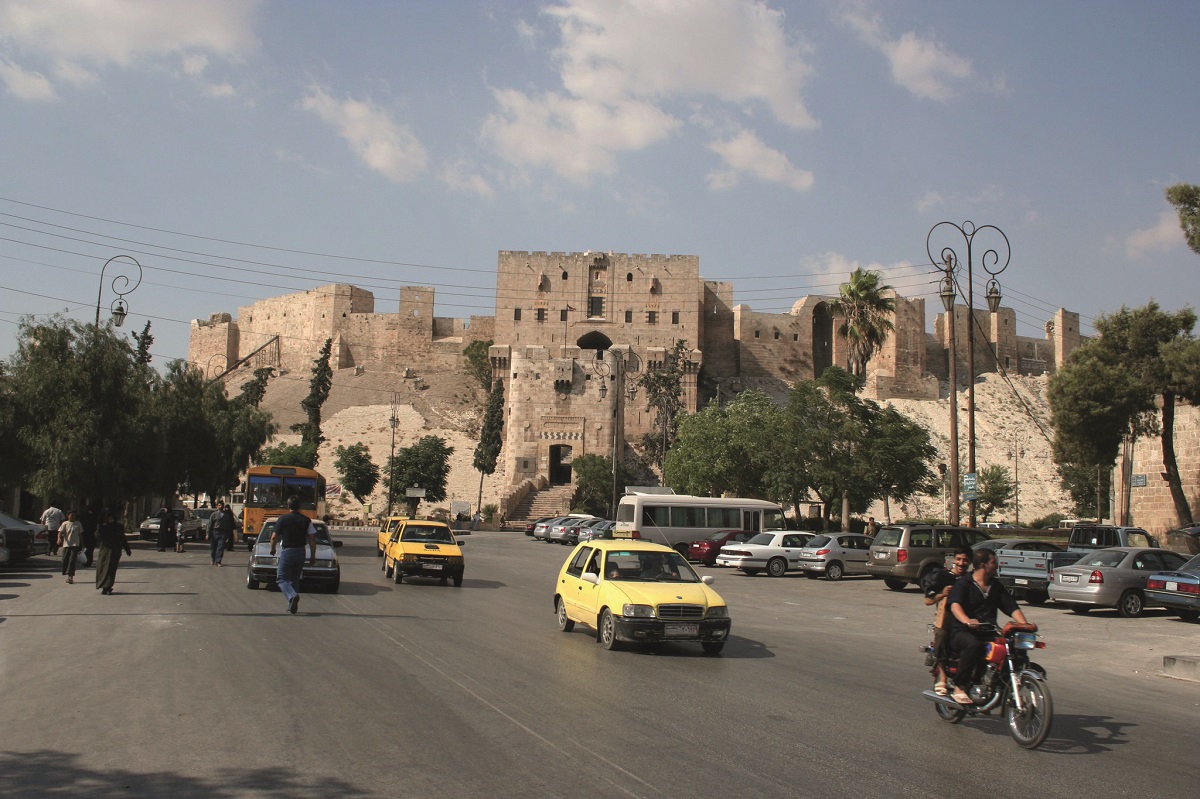
It may seem premature in the midst of the horrific destruction at the hands of all combatants, but especially Syrian and Russian forces, to imagine a future for this city, once home to more than two million. It is, in fact, already being planned. And the reconstruction of Aleppo is itself a site of struggle. When the fighting ends, the city will, in one way or another, be rebuilt. But on whose terms?
As one urban planner told the Guardian, “If we don’t start with a reconstruction plan now, we’ll pay for it for the rest of our lives, because the moment there’s a peace agreement, international investors, especially from Saudi Arabia and Lebanon along with corrupt officials from the Syrian government, will pounce on the city and guarantee that Aleppo loses its historical face once and for all.” To that end, plans are already being drawn up, ranging from the speculative—like those from a housing competition organized last summer by an architectural group called Matter Better, open to Syrians and non-Syrians alike—to the technical, by a group of Syrians in Beirut working on a UN-backed project called the National Agenda for the Future of Syria. Syrian and German architects in Berlin, many of whom worked with GTZ in Aleppo, have their own initiative, Strategies for the Reconstruction of Aleppo. As the Guardian described these efforts, “the movement plans to reconstruct the city regardless of who wins the war.”
That now looks like Bashar al-Assad’s regime. And the reconstruction of Aleppo on Assad’s terms could be another conflict in itself. The regime has already created a ministry for reconstruction, which has sold contracts for redevelopment. Land registry records have been destroyed in the fighting, which some allege was a deliberate act by the regime and its supporters to wipe out ownership claims and seize what remains when the war ends.
The warning signs are next door. After 15 years of civil war in Lebanon, the shattered center of Beirut was rebuilt in the 1990s and 2000s by a single private real estate company, called Solidere, whose largest shareholder was the country’s billionaire then-prime minister, Rafik Hariri. Solidere bought up much of the former downtown and made reconstruction into a high-end investment drive, with little regard for preserving ancient Roman artifacts unearthed below the city’s rubble, let alone 19th- and 20th-century architecture. The result was a sanitized central business district that catered to luxury stores, real estate, and brand-name global architects. The new Beirut declared itself a hub for Lebanese and foreign elites, but not for most Beirutis.
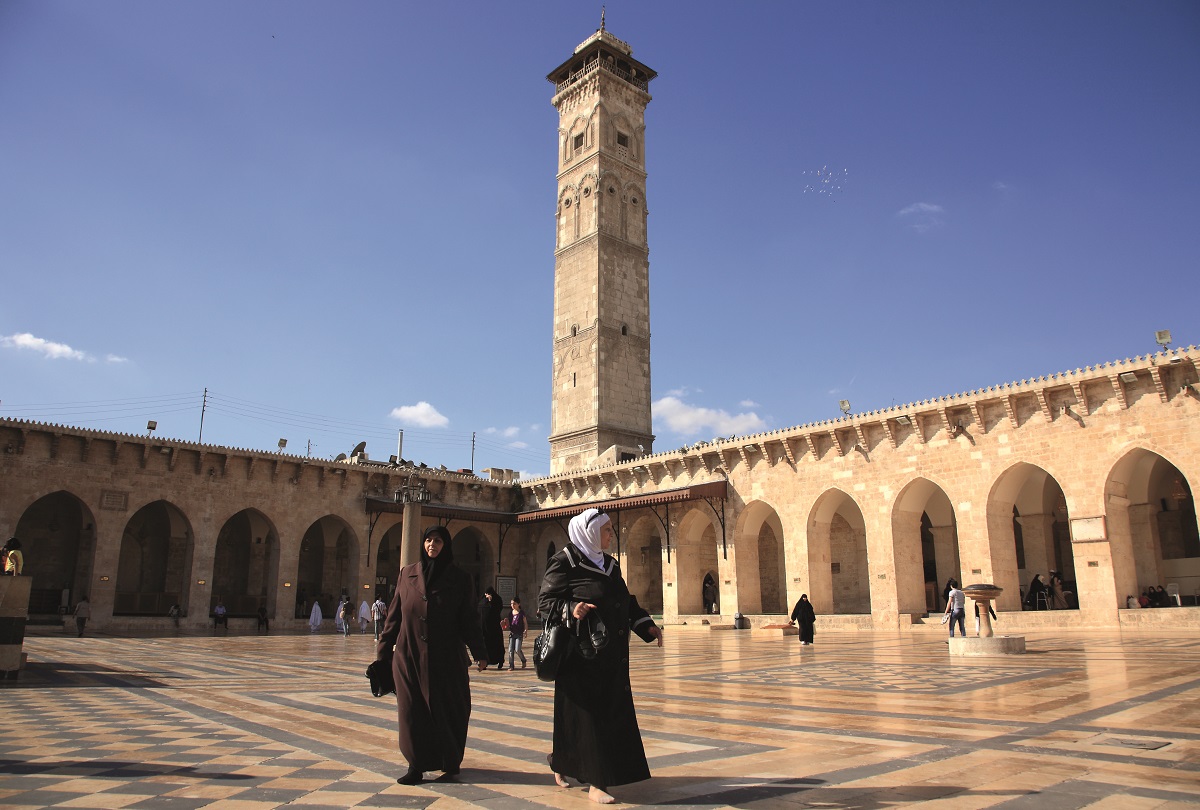
In April last year, the World Bank estimated Syria’s entire reconstruction costs at a staggering $180 billion. There are more immediate post-conflict questions—clearing unexploded ordnance, or housing displaced residents. But if and when those immediate troubles are resolved, a bigger question will remain: what sort of future life awaits Aleppo once this war ends, and who will be the people who shape it? To answer that question you have to look not just forward, but back. Whenever it comes, rebuilding Aleppo will have to balance what remains with what was lost. That means not only taking stock of the city’s destruction, but also cataloguing work done before the war—the golden years of the city’s preservation.
II.
A scale model of Aleppo showed the city bathed in white. The medieval Citadel towered over the Old City and neighborhoods to its north—old neighborhoods, too, despite names like Jdeideh, meaning “new” in Arabic, which the neighborhood was when it developed under the Ottomans in the 16th and 17th centuries. Round minarets poked up from the model’s otherwise featureless buildings, which showed the density and tight urban fabric of Aleppo more than any architectural detail. This model was housed in a building in the Old City, not far from the grand Umayyad Mosque, just south of the Citadel. The mosque’s 11th-century minaret was leveled in 2012, probably shelled by the government.
GTZ had set up this miniature Aleppo as part of an exhibition of its preservation work in the Old City. I saw it on June 20, 2009, my last trip to Aleppo during a year I spent living in Damascus. I was in Syria to study Arabic and research architectural preservation, mainly in Damascus, which was drawing lessons from Aleppo. At the time, around 100,000 people, or 5% of Aleppo’s population, lived in the Old City. Still largely ringed by medieval walls, the Old City was celebrated by architects, preservationists, journalists, and others as the model of urban restoration in the Middle East, if not the wider Islamic world, in large part due to the work of organizations like GTZ and the Aga Khan Trust for Culture (AKTC). They had a lot to work with: Aleppo, like Damascus, still had a vibrant and architecturally intact historic center, home to textile and traditional manufacturing, along with busy, picturesque markets that sustained urban life like they always had. Aleppo began attracting more and more tourists, and boutique hotels and restaurants were opening up in renovated courtyard houses.
Before the war, GTZ and the AKTC focused on social and economic development to improve the lives of those living around the Citadel, who were mostly poor. More than four million tourists were visiting Aleppo each year, the AKTC reported in a publication at the time, but those tourism dollars weren’t reaching the Citadel’s inhabitants, who were among Syria’s most marginalized, earning less than a dollar a day. The AKTC helped pedestrianize roads in front of the Citadel, creating a plaza for the surrounding communities; it was also planning a 42-acre park on a barren lot south of the 13th-century Bab Qinnasrin, one of the Old City’s stout southern gates.
These neighborhoods are now known in news reports and YouTube videos as part of besieged eastern Aleppo, and the civil war has undone most of the AKTC’s work. The once tidy, palm-tree lined plaza that the former New York Times architecture critic Nicolai Ouroussoff called “one of the most far-thinking preservation projects in the Middle East” is now rubble-strewn, a few surviving trees providing some of the only protection against snipers. Restored Ottoman-era buildings around the plaza, including one that was converted into the boutique Carlton Citadel Hotel, have been annihilated. Either the Syrian army or Assad’s Alawite militias—known as shabiha, or “ghosts”—commandeered the Carlton Hotel early in the battle for Aleppo. Islamist rebels blew it up in May 2014 by packing explosives into a tunnel dug underneath it: a tactic going back to Roman times.
Earlier this year, the current Times architecture critic, Michael Kimmelman, had a different assignment for Aleppo, undertaken from the safety of his desk: surveying drone footage over the wreckage of the city’s eastern neighborhoods. “The destruction is so complete that it obliterates even a sense of time,” he wrote. “Toppled rooftop satellite dishes, choked by plaster dust, resemble wilted flowers. Figures move through the pulverized rubble but are hard to make out.”
III.
Urban preservation has a relatively short history in many cities in the Arab world. The historic heart of Cairo, for example, was neglected and vilified by Egyptian officialdom as a slum. For many Cairenes, the view of Islamic Cairo, an area once celebrated for its thousand minarets, came from an elevated highway that cut right through it. More recently, when governments, prodded by the likes of UNESCO or seeing the appeal of tourism revenue, started preserving old buildings, like a mosque or palace, they often still neglected the surrounding neighborhood, or kicked out locals who might turn away tourists.
Syria always seemed better. In Cairo, whenever I mentioned Damascus or Aleppo to Egyptian architects and urbanists, they expressed longing. Not jealously, but a sense that more had been preserved in Syria all along, and that more was being done to protect that heritage. The war hadn’t begun yet.
When the popular uprising turned into a civil war, cultural sites were caught in the crossfire or deliberately targeted in the fighting. A seemingly disproportionate international focus on the war’s cultural toll—captured most of all by the Islamic State’s iconoclastic rampage in the Roman-era ruins of Palmyra in 2015—provoked its own reaction among urbanists and architects. What part of Syria did the world really care about?
AlHakam Shaar, a researcher for The Aleppo Project—an open collaboration among Syrian refugees, academics, and policy experts based in Budapest at the Central European University’s School of Public Policy—worried about the misplaced valorization of urban space in his besieged hometown. “We turn these buildings, and too much of the Old City, into museums for us and the world. We need to remember that there’s more that matters: the lives that have been lost, all the different dynamics within the community, mainly through the drain of its population.” We spoke in late November, and the news every day was of another advance by Syrian and Russian forces into eastern Aleppo, an attempted counterattack by rebels, another hospital destroyed, another hollow warning for civilians to leave. “Aleppo has clearly experienced an attempted campaign to depopulate it, in order to weaken it.”
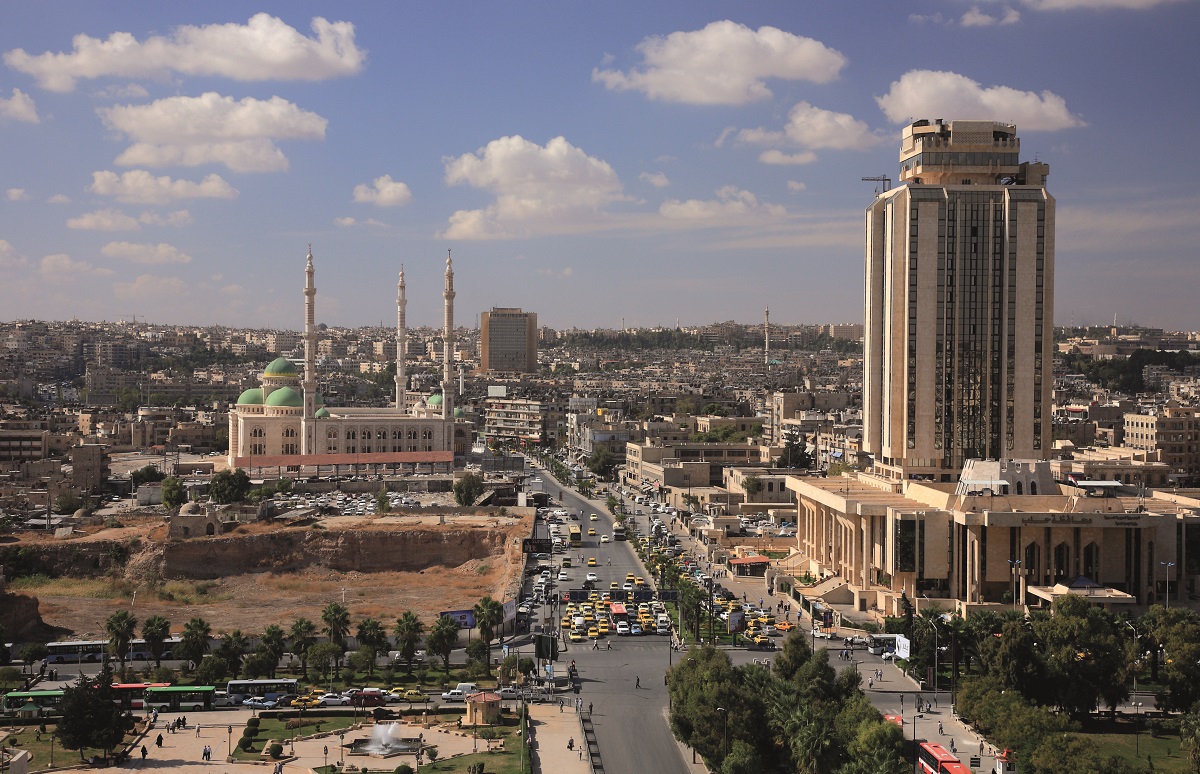
Shaar’s focus is on the Aleppians still in their city, documenting damage, posting photos and videos to Twitter and Facebook, creating online forums and discussion groups, helping to create a record of what is being lost so that they might know how to rebuild. That grassroots version of urban planning extends to his sympathies for all the victims in Aleppo. He recalled feeling devastated, initially, if an old house or mosque was destroyed, but less so if it was one of the hastily constructed, unplanned apartment buildings that crowd many eastern Aleppo neighborhoods; as the war dragged on, his views changed. The loss of a nondescript apartment block is just as important as a well-known public space, he said, “when I remember that these are all the homes of people, who grew up there in these rooms, from being toddlers onwards. Each corner has a meaning to them.
“You need to politicize urbanism and how you think about it,” he insisted. “Aleppo still has a huge community of thousands of people who contribute on a daily basis, interacting with elements of their city, including its cultural heritage. Maybe you can frustrate people, you can frustrate intellectuals, you can frustrate the larger population even, but you cannot kill hope or vision for the future. And in more practical terms, you cannot really stop research.”
IV.
Over four months in late 2014 and early 2015, researchers from The Aleppo Project interviewed 1,004 Syrians from Aleppo. Their survey was an attempt to record the memories of people who had fled the city, and to find out what, if any, visions they had for its future. Would they return? 72% said yes. The survey is accessible in a downloadable Excel spreadsheet, its questions and answers cataloged in rows and columns that cannot contain the suffering, or the vagaries, of this war. Was your house destroyed? 678 said no; 254, yes. But there are other responses: “partially,” “largely,” “I don’t know,” “it was damaged a little and robbed,” “almost,” “under the control of militants,” “the shabiha occupied it,” “the army took it and made it an operation room,” “yes, the regime occupied it and stole everything.”
These Syrians—some in Turkey, others scattered around the world, many still in eastern Aleppo—had more to tell the researchers, who collected enough information to create discrete snapshots of life under siege, or in exodus. The man whose house was occupied by the shabiha was 26 and had stayed in eastern Aleppo, in the district of Salah al-Din. He had a secondary school education, identified as Sunni, and before the war worked a private-sector job. He didn’t have any children. Asked why he didn’t leave Aleppo, he replied, “Because it’s my home, my city, my land.”
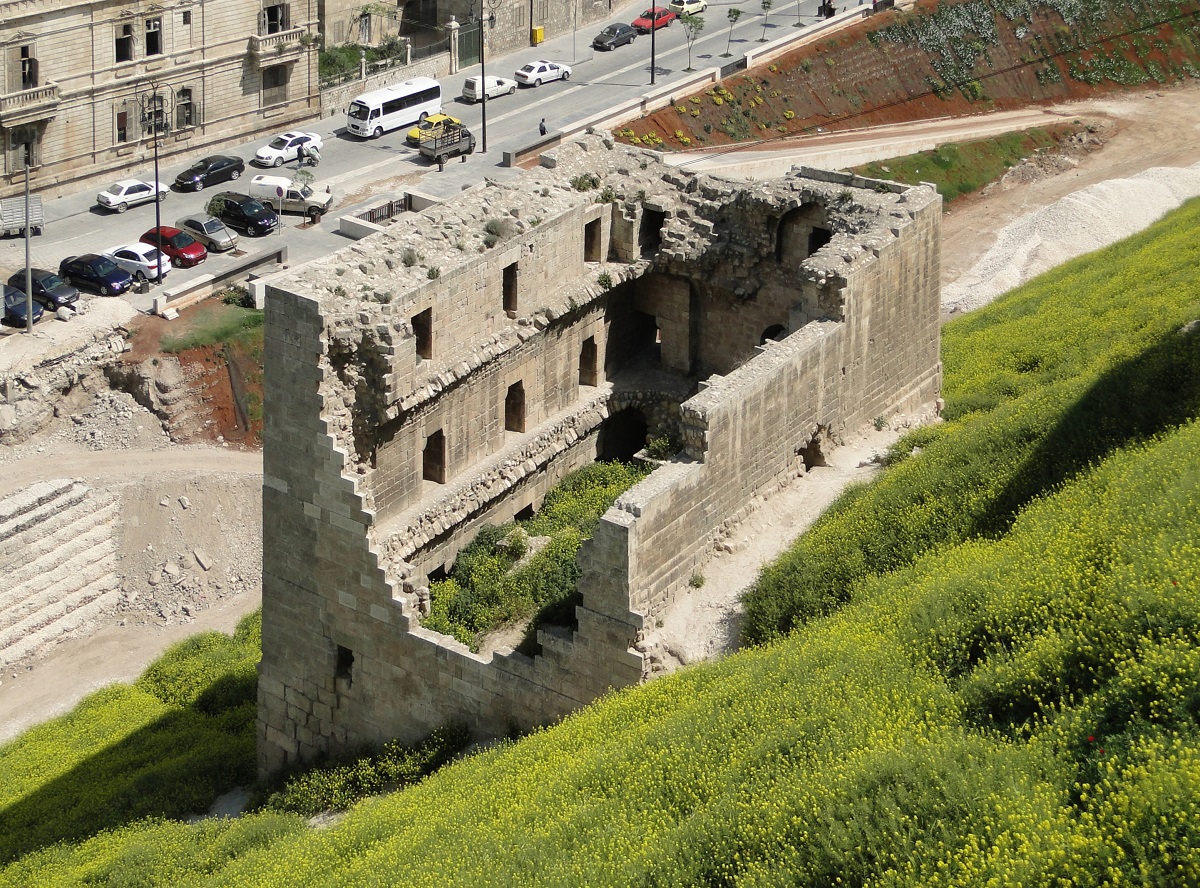
The Aleppo Project’s website includes an interactive, neighborhood-by-neighborhood map of the city, developed by Columbia University’s Center for Spatial Research, where users have uploaded both photos of the war’s destruction and ones that preceded the war. People are invited to annotate sites and add “narratives.” It’s still a work in progress, but the busiest section is the Citadel. Idyllic prewar photos of couples taking in the view from high atop the medieval fortification, and of the sunny pedestrian plaza below its imposing entrance, contrast with one of an entire section of wall that is blown out, its stones tumbling down the huge defensive mound that rises over the city. There is one annotation: “Until Syria’s current civil war, the Aga Khan Trust for Culture was mapping the Aleppo Citadel and paying for conservation work.”
In explaining the need to plan for the day after, even when every day means more war, Robert Templer, who leads The Aleppo Project’s four-person team in Budapest, noted that “the British and American governments in World War II started planning for the end of the war really by 1942 or so—three years before the war actually ended.” By contrast, in Afghanistan, there was “little thought about urban reconstruction” in Kabul, and that real failure to listen to the public had led to support for the Taliban and made conflict more likely.
“Even in these very extreme situations like Syria, it’s necessary for at least some people to be thinking into the future,” he added. The work isn’t easy, whether to attract attention or raise funds for research. But many Syrians don’t have to be convinced. “They understand the idea and understand the necessity to think about this—and understand, to some degree, the psychological need to focus on a future. Even when that future is very uncertain.”
Documentation is key to that future, and this is arguably the most documented war in history. Reporters may be widely barred, but every day firsthand material is broadcast from Syria on social media. Laura Kurgan, a Columbia professor, studies urban damage as the lead investigator of a university project called Conflict Urbanism: Aleppo. Capitalizing on new data, mainly satellite imagery, and a call for collaboration with groups like The Aleppo Project, Kurgan’s Center for Spatial Research developed an interactive, open-source map of the city that is navigable by neighborhood. “These maps,” Kurgan explained, “will show that Aleppo was actually a very vulnerable city, in part, because of the way the main roads traverse the city. It’s really easy to just block off large parts of it.” By now, most of those roads have been damaged or blocked with debris. An updated map is overlaid with thousands of data points about damage to buildings in color-coded dots—“red: destroyed; orange: severely destroyed; yellow: moderately damaged.”
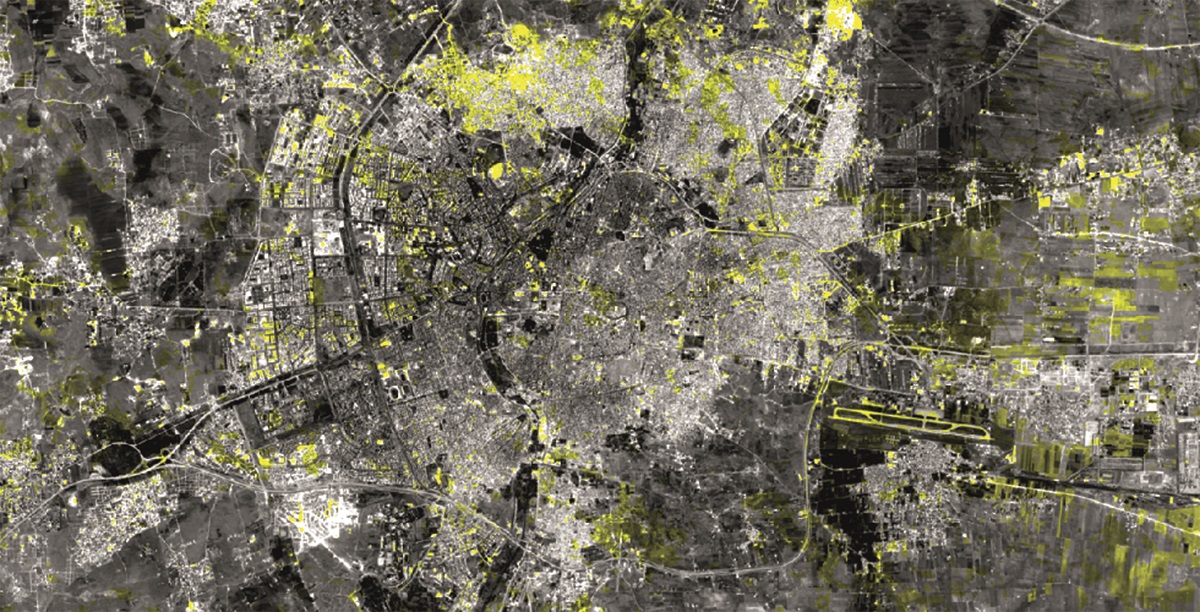
You can toggle among four different years of satellite views; the change between 2012 and 2014 is the most jarring. It visualizes, from high above, the destruction to the base of the Citadel and all the work done by GTZ and the AKTC. A dense collection of buildings—the Carlton Hotel, covered markets, and the medieval Khusruwiyah mosque complex, designed by the revered Ottoman architect Mimar Sinan—disappear into a few craters. The plaza by the Citadel remains, still full of palm trees. By 2015, there is more destruction, including an Ottoman-era government building once restored by the AKTC and the 13th-century al-Sultaniyeh madrasa that framed the plaza. By 2016, patches of green have filled in parts of the rubble.
Kurgan and her colleagues were working on an additional overlay to their map that geolocates YouTube videos to their specific neighborhood. The greatest number of videos so far, 121, was in al-Shaar, a neighborhood northwest of the Citadel. The map lays out attacks on the city writ large, with the heaviest concentration, of course, in the eastern ring of neighborhoods under rebel control. And there were two videos geolocated at Bab Qinnasrin, where the AKTC was building the 42-acre park. One video is shot from inside a devastated palace. Much of its roof is gone, but the liwan—the vaulted portal off the courtyard, open to the outside—is still intact. The other video pans over the quiet but brutal wake of a barrel bomb: two small, bent and busted trucks, and a Peugeot, amid piles of stone rubble bleached white in the sun against a bombed-out section of the Old City’s walls.
V.
The hope for Aleppo’s reconstruction runs up against the reality of urban erasure. “The idea that we will keep the Aleppo we know is finished. We should forget about that,” said Thierry Grandin, a consultant with the World Monuments Fund who lived and worked in Aleppo for decades. “There are a lot of buildings that have been destroyed completely, especially south of the Citadel. Those buildings will disappear. They are a part of history, they will remain a part of history, but this is done.”
Some cherished or historically significant buildings could be rebuilt. Plans exist for the burned-out souq to be restored, according to Grandin. The battered Umayyad Mosque and its toppled minaret will probably be rebuilt, too. But one could imagine other urban ruins having a future like Dresden’s Frauenkirche, the 18th-century Lutheran church that was destroyed in the Allied bombing, its remains left as a war memorial for 50 years. After German reunification, the government decided to rebuild it, and the church reopened in 2005, six decades after its destruction.
“Perhaps the minaret could be a symbol,” Grandin said of the Umayyad Mosque. “But perhaps traces of what happened should be kept in the city.” One of the centuries-old mosques at the Citadel plaza was built of rough, unhewn stone; if rebuilt, it would be a copy, a pastiche.
Syria’s cities have been destroyed and rebuilt before—in the case of Damascus, in 1925 when the French put down an anti-colonial revolt by shelling the Old City and killing at least 1,500 Damascenes. It was an act of modern urban destruction that predated Guernica by 12 years. When the hardest hit part of the Old City was rebuilt, Damascenes called the area al-Hariqa, “the fire,” lit by French bombs. The name holds today, listed plainly on maps. Under French colonial control, al-Hariqa wasn’t rebuilt according to its historic fabric, but instead on a 20th-century block plan, with a neat grid of commercial streets centered on a pedestrian plaza. It is an outlier of urban regularity in Damascus’ winding Old City, forming an unintended memorial to the violence and the neighborhood that was lost, though you wouldn’t have known it from the busy department stores and tailors. Eventually, Syria will have many more neighborhoods like that.
As for people’s homes, their private spaces, much more will be lost. The issue of documentation remains: what was destroyed, and who owned it. Damage in the city is still difficult to assess, and organizations like UNESCO and the UN Development Program are focusing on the central city of Homs instead, which has been back in government control since last year. Marwa al-Sabouni, an architect in Homs who has remained there throughout the war, submitted a proposal to a UN competition for the reconstruction of a former rebel stronghold known as Baba Amr, which became an image, in gnarled concrete, of the worst of Syria’s war. Her plan transformed the traditional density of Syria’s urban fabric—the narrow streets, covered alleyways, and courtyards of Aleppo’s and Homs’ now-ruined Old Cities—into a series of stacked and cantilevered homes. The Syrian government rejected it, in favor of its own plan for a series of high-modernist apartment towers that could be anywhere, and will probably be built with Russian money.
“I don’t necessarily have hopes for my work to be realized,” Sabouni told me. “But I hope that our cities and towns would be given a chance to be built in a sensitive way and with a similar understanding to what I and others around the world are advocating. Namely, an architecture that will touch upon people’s real needs. It is our job not to lose hope.”
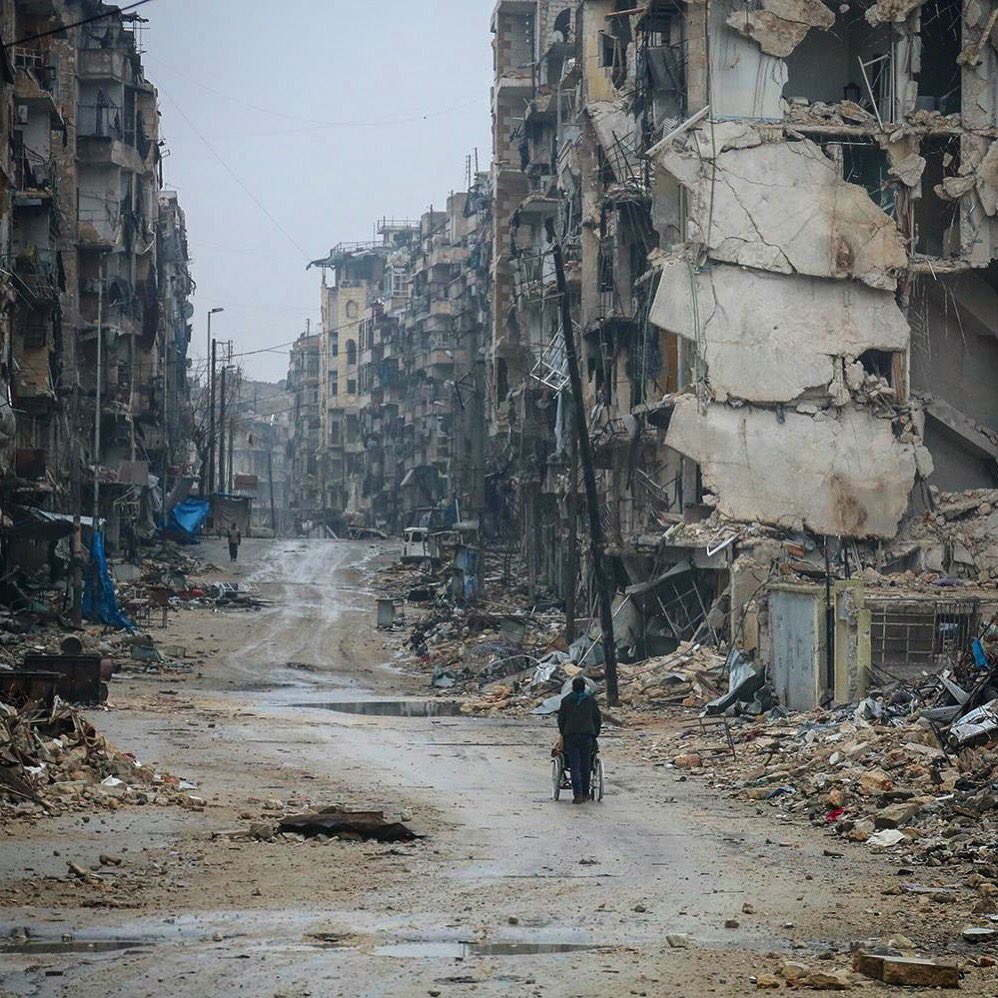
Yet there are legitimate fears that Aleppo could be punished further after the fighting ends. After all, when Hafez al-Assad quelled a Muslim Brotherhood-led uprising in Aleppo in 1980, he made sure the city paid for the insurrection. After 1,000 were killed and 8,000 more arrested, his government marginalized Aleppo economically and razed a neighborhood in the Old City. Aleppo’s reconstruction under Bashar al-Assad now looks like a replay of history, only worse. Assad’s regime will probably claim, falsely, that it is the guardian of Syria’s history and identity as it seeks to rebuild an ancient city it largely destroyed and depopulated. “We asked for a free Syria,” Salah al-Ashkar, an activist, said in a video from eastern Aleppo, as he looked down on a street packed full of civilians waiting to evacuate in mid-December.
“We asked to remove al-Assad. No one supported us, or even helped us. And as you can see, we are being kicked out of our city, we are being kicked out of our country.” Ashkar trailed off. “I will go out of Syria and—I don’t want to. I don’t want to leave.” He shook his head and stared into the camera for a moment. Then he tilted it sideways, and the street below disappeared from view.